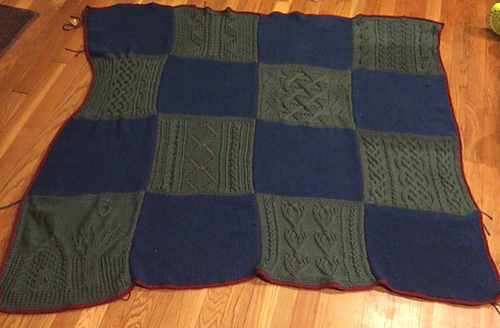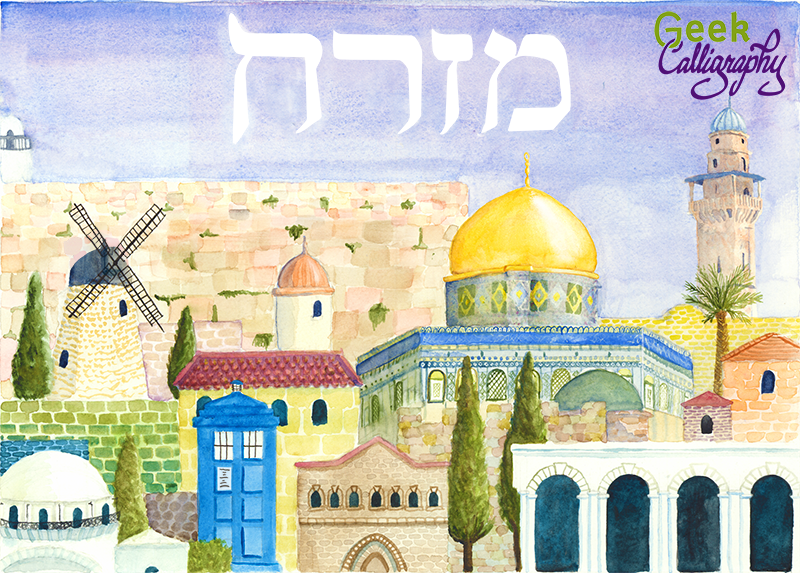by Terri
Note: unlike Ariela, my creative skills did not manifest in an ability to draw with any proficiency. While this post will be liberally illustrated with photographs, it will not contain chibis.
Back in 2008, two of my best friends announced that they were engaged and would be getting married the following June. I was asked to be a groomsmaid. Ariela was making their ketubah, and I was going to knit them a beautiful heirloom afghan. At that point, I'd been knitting pretty steadily for around 3 years. I'd made socks, a much smaller blanket than I was planning, scarves, hats, and a lace shawl. I'd even designed a fingerless mitt pattern.
I was going to use pattern squares from The Great American Aran Afghan book and alternate them with some plain stitch pattern squares. I was going to borrow a technique from the blanket I'd already knit and get myself out of having to sew every square together. It was a brilliant plan, and the blanket would be ready by their wedding.
HAH.
Image shows one of the plain squares in progress. It is a dark blue yarn, knit in seed stitch.
I started knitting the afghan in October of 2008, after confirming colors with the recipients. I was chugging along on a project that I had no idea was biting off way more than I could chew. Initially, the afghan was going to have 5 strips of 4 squares each. I'd done a little swatching, so I knew how to get a one foot square from the yarn and needle size I thought would work for all the squares* in the plain blue squares. I was working from cable charts that I wasn't entirely sure how to read, and disregarding actual pattern instructions willy nilly.**
It's now too long ago to remember exactly why I slowed down the work. My personal life was kind of a mess, I was working full time and beginning to start part time community college. The notes in my Ravelry project page are sparse. I just know that Josh & Liz were married on June 28, 2009 and that the afghan was far from finished. I have a note saying that I needed to get working on the afghan again from December 2010. By then, they'd been married for a year. I think I had finished one strip of 4 squares.
In February of 2011, I got engaged. Both Liz & Josh were going to be in our wedding. By March of that year, I'd picked up the afghan knitting again, thinking that it would be a good "thank you for being in our wedding party/2 year anniversary gift." I finished a second strip and attached that to the first so I could have an idea of what the thing was actually going to look like. That was when I should have noticed that ignoring how I was measuring things was going to make the project hard to fit together, but the bulldozer in me decided it was all going to be FINE. It's a good thing I didn't plan on knitting anything for my actual wedding that August, since wedding planning basically ate my life.
Ariela and Benjamin's afghan in progress on a lovely sunny day in New York City.
Every so often, I would pull out the afghan and knit a couple of rows. It bored me at that point. I would joke with Josh & Liz that it would be done for their "X anniversary." When Liz went to California to do her PhD and Josh had to stay behind in New York City, I told them that it would be done by the time they were living in the same city again (giving me a three year window for Liz's coursework to be completed), or at the very least before their first child was born. In the interim, I cast on and completed another wedding blanket - this one for Ariela and her husband. In contrast to the epic afghift, this one only took just over a year to complete.*** In 2013, I got pregnant with my daughter, and then baby knitting consumed my entire brain. Then my daughter was born, and I had no brain left to think about knitting anymore.
Image shows afghan as of August 18, 2015. It is composed of three strips of 4 squares each. 8 of those squares are blue seed stitch, 8 of those squares are green (the light is very yellow saturated, but I promise they're green) in various cable patterns.
In 2015, I decided to do a project running around on social media called #yearofmaking. I would dedicate more efforts into my various projects and finish some of the things lying around my baskets, documenting the process along the way. I decided that this would be the year I finished knitting that damn afghan. The fact that Liz had moved back to New York to write her dissertation and they were expecting a baby may have motivated some of those decisions.
I'm not a monogamous knitter by nature. I have a big problem with startitis, and people did persist in having kids that year that needed wee baby sweaters. But by August 2015, I had finished the third afghan strip. I seamed it with the other two and realized that If I made the entire afghan as I'd originally planned it, It would be huge. And that I had no interest in doing that. So culled two pattern squares from the 4 left in the initial project plan and decided that they would be it. And to my credit, I did finish the afghan by September 21, 2015. Well, I finished knitting it anyway. And I got a baby sweater done for Josh & Liz too.
The thing about knitting a project this big is that just finishing the knitting isn't enough. The picture accompanying this paragraph demonstrates this to significant effect. The edges are really funny looking, pulling in in some places and puckering out in others. The pattern squares aren't the same size as each other, let alone all the plain squares. There are yarn ends all over the place from changing colors and balls of yarn. In order to turn that mess into something that would look respectable on someone else's couch, you need to employ the magic of blocking.
The afghan as of September 21, 2015. All of the pieces are knit, seamed together and edged in crochet.
Image shows me holding a very small steamer over the afghan all pinned out on our IKEA sofa bed in the bed position. This is what one kind of blocking looks like.
Depending on the size of your project, blocking can be simple or it can be complicated. When I block a pair of fingerless mitts, I dunk them in the sink with some wool wash, wring them out, then lay them out on a dish drying mat until they are dry and ready to go. A baby sweater can take the same dunk, but needs to be wrapped up in a hand towel and then stomped on to get the bulk of the water. As you increase size and various elements of complexity, wet blocking stays relatively simple, but you start needing bigger surfaces to dry the project on.**** With a shawl, you often have to pin it into the correct shape while wet so that it drys in that shape.
With something as big as this afghan, I'd have needed to soak it in the bathtub for it to get properly wet. And it still needed a huge surface to dry on. Also, since the edges were so weird, it would need to be severely pinned in place to ensure that they would dry straight. And in our first Boston apartment, we didn't have any space that big. We did have a futon, but ever since setting up the crib in our daughter's room, it stayed a couch. There was also a desk in that room, so it was hard to open the futon. And our little baby was no longer a lump that would stay put. She was mobile and inquisitive. I honestly didn't know where I would be able to block the afghan. So it sat in a box for almost another year.
December 20, 2016. The afghan is seamed, edged, blocked, and all the ends are woven in. 8 years after casting on, the afghan is done. It is 4 squares by 4 squares.
When we moved to our new apartment in July of 2016, we got a third bedroom. We purchased the IKEA sofa bed the previous tenants had in that room, put our big heavy desk in there, moved all my yarn in, and made it the office/craft room. It would also be the spare bedroom for when we had guests stay over.
We unpacked the house, got rid of the boxes, and still I had a box labeled "Hibernating WIPs***** and Josh & Liz's afghan." It never seemed the right time to deal with the monster.
In December, we had some good friends stay over. I was unmaking the bed from their stay and noticed the box in the corner. I decided that I would just take care of the afghan right then and there. I pinned out the blanket so that it covered most of the bed's surface. I plugged in my teeny handheld steamer and ran it over and over the afghan, relaxing the stitches with the warm water vapor. I let it sit drying for over a day. And when I unpinned it, it stayed basically the same shape. I sewed in all the loose yarn ends and trimmed them. On December 20, 2016, the afghan was finally finished. I wrapped it, put it in a box, and mailed it off to Josh & Liz, where it now sits on their couch.
The afghan in its correct home, only 7 years too late.
I learned a number of things knitting this afghan. Here are some of them, though this is not an exhaustive list:
- The definition of "portable" is malleable and really means "anything that will fit in my messenger bag."
- I hate crochet, but I can do it smoothly enough, and now know how to turn corners.
- I can fix cable mistakes from the wrong side of the knitting
- When I began the project, I vastly underestimated this particular undertaking
- There isn't much I won't do for friends. Introduce them to the love of their lives, crochet, shackle myself to a seemingly unending project...
- Two rounds of single crochet around 16 square feet will use most of a 50 gram ball of yarn.
- No matter how much I love you, I'm getting something from your registry as your wedding present.******
Now that it's done, I am trying to reassure myself that I'll never take on something this ridiculous again. Check back with me in a few years to see how that went, OK?
*SPOILER ALERT: I was wrong
**This wasn't the first time, and it sure wouldn't be the last time
***I thought that this project was much more reasonable. It was a single pattern, knit from the center out. I still wound up hating it.
****And bigger towels to wring the project out with
*****Works In Progress
******This is why there is a line in the Fiber Artists Oath that says "I pledge to be honest with myself about my production speed and remember that it really is okay to give even very beloved people a gift other than a handmade Something."















